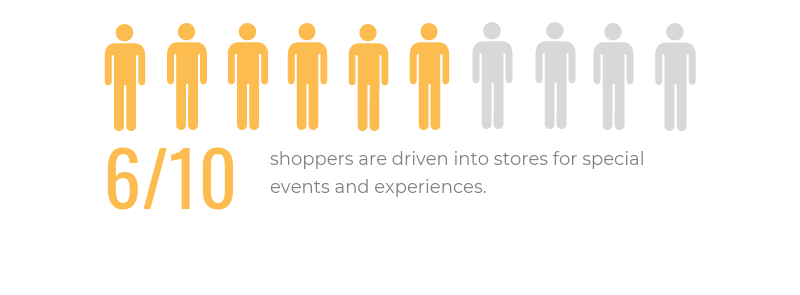3 Reasons Why Your Ecommerce Store Needs a Physical Location
In 2013, online eyeglasses retailer Warby Parker announced its first, flagship retail store in New York City—three years after launching online—setting a trend of ecommerce companies opening brick-and-mortar stores.
Warby Parker realized early on that as customers’ expectations increased around “convenience” and “efficiency,” it needed to meet customers where they are in the world in order to meet their expectations.
No matter how well-designed a website is, customers value the personal experience of a physical store.

Nearly six in 10 shoppers are driven into stores for special events and experiences, including the ability to try out products, exclusive access to sales, product demonstrations and tutorials, according to the NRF.
Brick-and-mortar + Ecommerce = Omnichannel
Online brands like Casper, Harry’s, Everlane, and Allbirds are among the many that have recognized that there’s no longer “online” and “offline,” but “omnichannel.” There are now about 600 stores across the country from these online natives, according to real estate research firm Green Street Advisor.
For these online stores, moving into the physical retail space serves as a way to gain exposure, new customers and further insights into shopping behavior.
For more information on this subject, we spoke to someone with experience going from ecommerce-only to establishing a brick-and-mortar location.

Joe Flanagan
Project engineer and specialist marketer at Tacuna Systems
Tacuna Systems conducted a study of its customer data and discovered the following three benefits of having a brick-and-mortar store.
1. In store saves time and shipping costs
While Tacuna offered shipping to anywhere in the U.S., it found that the majority of its shipping orders came from its home base in Colorado.
“After a cost analysis of the amount spent on shipping, we realized that it would be quite profitable to have a physical store in Colorado.”
Joe Flanagan, Project engineer and specialist marketer for Tacuna Systems
Ecommerce and brick-and-mortar stores must work hand-in-hand in meeting the customer where they are. A majority of shoppers (87%) begin product searches online while almost half (46%) still prefer to buy in a physical location, according to research from Salesforce and Publicis.Sapient.
This benefits the profit margin of your overall business. If customers are buying in store, they don’t have to pay shipping costs, which means it’s an expense you don’t need to account for.
WHAT YOU CAN DO: You’ll gain a competitive advantage by offering your physical store as a pickup location for online customers. Only 37% of retailers offer click-and-collect worldwide today, according to research by Distributed Order Management (DOM) System.
Start by testing click-and-collect with a few select and smaller products and see how customers take to it. One retailer saw a 35% increase in sales when it gave customers the option of picking up purchased products in its physical stores that they had bought online, according to a Harvard Business Review report.
2. Human interaction is key to customer experience
Why do people buy in person? Tacuna’s survey found that customers would rather have the option to test equipment before purchasing than have the option to return faulty equipment for a full refund.
“Customers [said] that personal explanations on how to use purchased devices were far more appreciated than user manuals.”
Joe Flanagan, Project engineer and specialist marketer for Tacuna Systems
Having a brick-and-mortar also provides an opportunity for customers to conveniently return products. By making it easy for them to return products, you get another chance to engage a customer who might make another purchase.
That valuable in-person interaction will be crucial to delivering shoppers a memorable experience they’ll return for.
WHAT YOU CAN DO: Consider how you can create a unique and immersive experience that shoppers aren’t able to get online, such as custom personalization, free samples and trials, or face-to-face shopping tips.
Engage customers with promotional mailers, coupons, and invites to in-store events that will build loyalty and encourage more purchases. By surpassing customer expectations, you’ll have a higher chance of converting first time shoppers into repeat customers.
3. Boost traffic to ecommerce site; increase overall profits
When online retailers launch their physical stores, traffic to their ecommerce store increases dramatically, according to Gartner L2’s report, “Death of Pureplay Retail” (full report available to clients). More brick-and-mortar locations means an increase in online traffic, as well as an increase in the number of people talking about your store and searching for it online.
“Looking at the statistics of big online companies that would go on to open physical stores, we realized there was a spike in the number of first-time customers [online] following the opening of their physical stores.”
Joe Flanagan, Project engineer and specialist marketer for Tacuna Systems
Long term, this creates an online buzz along with increased financial returns, making the physical store a sound investment both in profitability and popularity, said the report.
“Simply knowing that there is a physical store somewhere puts first-time customers’ minds at rest that our business is legitimate,” says Flanagan. “All these contributed to our decision to open a physical store in addition to our online store.”
Why a brick-and-mortar location is the best thing for your ecommerce store
The future of retail will belong to retailers that can satisfy the customer, wherever he or she decides to shop.
In today’s omnichannel world, consumers are increasingly researching and making purchases across channels. In their mind, there’s no “online” or “offline.” They expect brand consistency, variety, and offerings across channels. A physical store can provide that competitive advantage.
Interested in opening a physical store?
Define the purpose (this can be one or more):
Convenience and proximity: Provides ease and speed for customers to get what they want fast.
Efficiency: Offers pickups and returns for customers.
Discovery of information: Provides customers with knowledge and expertise on products.
Ask “how can I do this profitably?”: Consider what’s needed to roll out the operating model such as staffing, employee training, and location.
Use analytical tools to inform your decision: Just as Tacuna found through its customer data that a majority of its online shoppers are based where it was, having the right tools and software will help make decisions around launching a physical store that much easier.
To learn more about your retail management, ecommerce, or data analysis software options, give our team of expert retail advisors a call at (844) 687-6771 for a free 15-minute consultation.